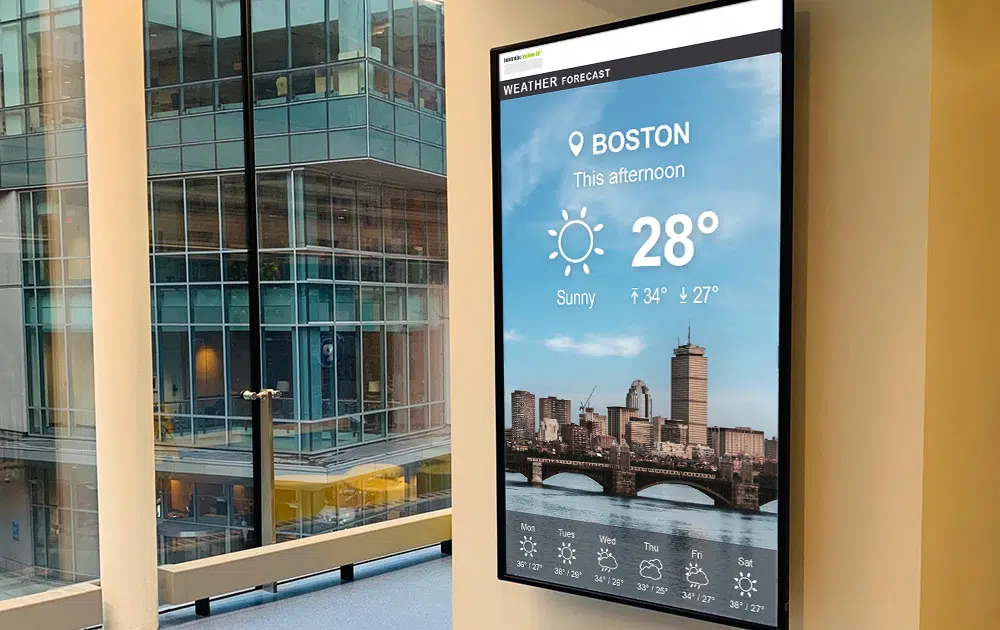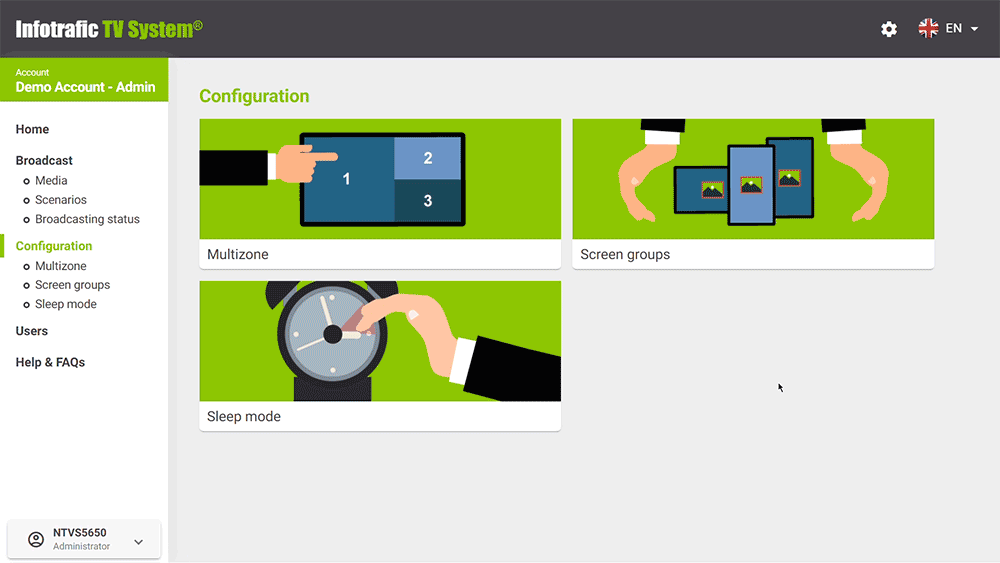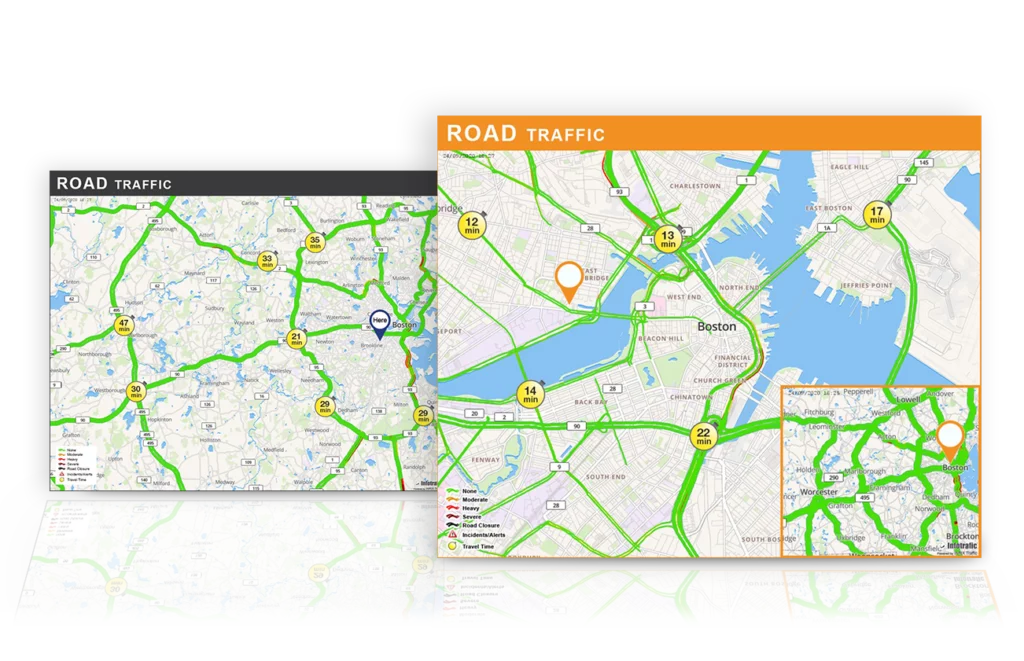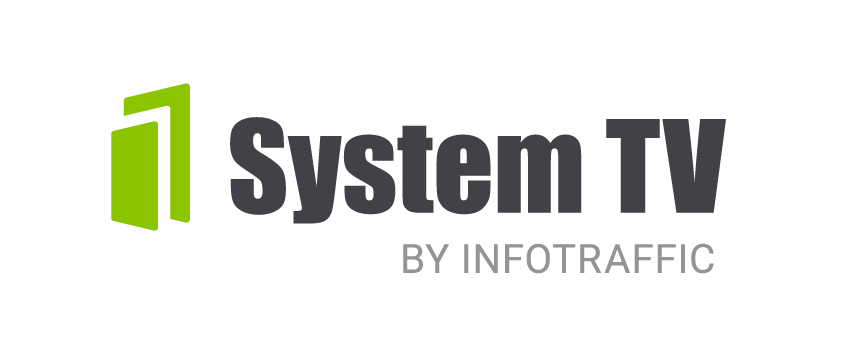The global digital signage market has been experiencing remarkable growth, with projections estimating it to reach a staggering USD 43.15 billion by the year 2028. As businesses increasingly recognize the importance of digital displays in engaging customers and enhancing brand visibility, the question arises: How much does digital signage cost in 2025?
Determining the cost of digital signage involves considering 3 key elements : hardware (which is a one time cost), software, and content (which are both ongoing costs). Moreover, you also need to take into consideration the installation costs, although these can vary significantly depending on factors such as the location, the number of screens, and the complexity of the setup. In this article, we’ll delve deeper into each of these cost components to provide a comprehensive understanding of how much digital signage typically costs in 2025.
Estimate the Cost of Your Project with our Digital Signage calculator
Choose your product
Choose your size
How many screens would you like to install?
What type of content would you like to display on your screens?
Here is the high-end estimate of the cost for your digital signage project
What You Need To Remember
- You need to consider 3 elements to determine the cost of digital signage: hardware, software, and content.
- For digital signage hardware costs, you should budget between $2,000 and $100,000.
- For digital signage software costs, expect to pay between $7 and $30 per month per screen.
- For digital signage content costs, budget between $15 to $25 per hour.

Hardware
When it comes to digital signage hardware, the primary expense lies in the selection of screens (however you should keep in mind other secondary expenses including media players, mounts, and any additional components necessary for the setup).These screens serve as the visual interface through which businesses communicate their messages to their target audience. This is why it is very important for businesses to choose the right one.
Consumer-grade TVs offer a relatively affordable option, with prices typically ranging from $500 to $2000. However, businesses must consider the durability and longevity of these displays. Consumer TVs are designed for personal use and may not withstand the rigors of commercial environments or prolonged usage. Their life cycle tends to be shorter, often ranging from 3 to 5 years, which could result in higher replacement costs over time. Learn more about the differences between digital signage and TV.
For businesses looking for a more reliable and long-term solution, commercial displays are the preferred choice. These displays are specifically engineered for continuous operation in commercial settings and offer a longer life cycle, typically lasting between 5 to 10 years or more. While the initial investment for commercial displays may be higher, starting at around $2000, the total cost of ownership over their extended lifespan often outweighs the expenses associated with consumer-grade alternatives.
Commercial displays come in various forms, including LCD panels or LED screens, catering to diverse business needs and preferences. Prices for commercial displays can range from $2000 for basic models to upwards of $100,000 for high-end, feature-rich displays with advanced functionalities and customization options. Businesses must carefully assess their requirements and budget constraints to choose the most suitable hardware solution that aligns with their digital signage objectives and long-term strategic goals.
In the next section, we’ll delve into the ongoing costs associated with digital signage software, another crucial component in estimating the overall cost of digital signage in 2025.

Software
In the realm of digital signage, the software plays a pivotal role in managing and displaying content effectively. With the advent of cloud-based solutions, also known as Software as a Service (SaaS), managing digital signage has become more convenient and efficient for businesses.
Cloud-based digital signage software offers numerous advantages over traditional on-premise solutions. One of the key benefits is accessibility, as users can manage their digital signage content remotely from any location with an internet connection. This flexibility enables businesses to update content in real-time, ensuring timely and relevant messaging to their audience.
Cloud-based software typically comes with a subscription-based pricing model. Businesses pay a recurring subscription fee based on their usage and the number of screens deployed. Subscription fees for cloud-based digital signage software typically range from $7 to $30 per month per screen, depending on the features and functionalities included in the package
Furthermore, cloud-based software providers often offer a range of features to enhance the digital signage experience, such as content scheduling, remote monitoring, analytics, and integration with third-party applications. These features empower businesses to create engaging and dynamic content experiences for their audience while gaining valuable insights into the effectiveness of their digital signage campaigns.
By opting for cloud-based digital signage software, businesses can streamline their operations, reduce overhead costs, and stay ahead in today’s dynamic and competitive marketplace. In the next section, we’ll explore the ongoing expenses associated with content creation for digital signage.

Content
Estimating the cost of content for digital signage can be a complex task due to various factors involved, including the type of content, its complexity, and the expertise required for its creation. While some content may be relatively simple to produce, such as static images or text-based messages, others, such as interactive or touchscreen content, may require more advanced skills and resources, thereby driving up the production costs.
For businesses seeking professional assistance in content creation, the cost typically varies depending on the scope and complexity of the project. Freelance videographers, calligraphers, and editors may charge anywhere from $15 to $25 per hour or per content item, depending on their skill level and experience.
One of the key value propositions offered by System TV is our ability to provide real-time digital signage content, including traffic updates, dynamic pricing, weather forecasts, and much more. This real-time content integration enhances the relevance and usefulness of digital signage displays, ensuring that viewers receive up-to-date and actionable information that meets their needs and preferences.
While estimating the cost of content for digital signage can be challenging, businesses can benefit from investing in high-quality, relevant content that resonates with their target audience. By partnering with System TV and leveraging our expertise in real-time content delivery, businesses can unlock the full potential of their digital signage investments and achieve their communication and marketing objectives effectively.

Is Digital Signage Profitable?
It’s natural for businesses to scrutinize the profitability of adopting digital signage as part of their marketing and communication strategies. Evaluating the profitability of digital signage involves assessing its return on investment (ROI) and weighing the costs against the benefits it delivers.
When calculating the ROI of digital signage, businesses must consider both tangible and intangible benefits. Tangible benefits may include increased foot traffic, higher sales conversion rates, and reduced printing costs associated with traditional signage. Intangible benefits, on the other hand, encompass factors such as enhanced brand perception, improved customer experience, and increased customer loyalty.
However, it’s essential to note that the profitability of digital signage depends on various factors, including the effectiveness of content, the placement of displays, the target audience, and the overall marketing strategy.
While the profitability of digital signage may vary depending on individual circumstances, businesses that invest in it stand to reap significant rewards. By leveraging the power of digital signage to captivate audiences, drive engagement, and deliver impactful messaging, businesses can unlock new opportunities for growth and success in today’s competitive marketplace.
Significant Investment for Maximum Returns
In conclusion, determining the cost of digital signage involves considering various factors, including hardware, software and content. While the initial investment may seem daunting, the potential benefits of digital signage in engaging audiences, enhancing brand visibility, and driving business growth are substantial. By carefully assessing their needs, budget constraints, and long-term objectives, businesses can make informed decisions about investing in digital signage solutions.
Moreover, with the availability of innovative platforms like System TV, businesses have access to tools and resources that can maximize the effectiveness and profitability of their digital signage endeavors. Ultimately, by embracing digital signage as a strategic communication and marketing tool, businesses can position themselves for success in an increasingly digital world.



